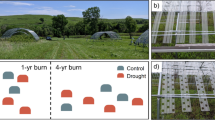Abstract
Substantial recruitment of Callitris glaucophylla in woodland, Sclerolaena birchii in cleared woodland, and Astrebla lappacea in grassland is related to catastrophic events of the past century in the form of interactions between climate, the impact of European land use (sheep, cattle, rabbits) and the rabbit myxoma epizootic. The direct effect of rainfall on the demography of these species and its indirect effect through competition via suites of accompanying plant species are examined. Major long-term changes in plant populations are generated by extreme sequential events rather than by random isolated events. One of the most potent climatic agents for change in eastern Australia is the El Niño/Southern Oscillation phenomenon.
Similar content being viewed by others
References
Adamson D. A. & Fox M. D. 1982. Change in Australasian vegetation since European settlement. In: Smith J. M. B. (ed.), A history of Australasian vegetation. McGraw-Hill Book Co., Sydney.
Auld B. A. 1981. Aspects of the population ecology of Galvanised Burr (Sclerolaena birchii). Aust. Rangel, J. 3: 142–148.
Auld B. A. 1983. Historical aspects of the Galvanised Burr problem in New South Wales. J. Aust. Inst. Agric. Sci. 49: 17–19.
Austin M. P. 1981. Permanent quadrats: An interface for theory and practice. Vegetatio 46: 1–10.
Austin M. P., Williams O. B. & Belbin L. 1981. Grassland dynamics under sheep grazing in an Australian Mediterranean type climate. Vegetatio 47: 201–211.
Blake S. T. 1938. The plant communities of western Queensland and their relationships, with special reference to the grazing industry. Proc. Roy. Soc. Queensland 49: 156–204.
Chiswell E. L. 1982. The Pilliga Story. Forest and Timber 18: 23–24.
Lacey, C. J. 1972. Factors influencing occurrence of Cypress Pine regeneration in New South Wales. Forestry Comm. of New South Wales Techn. Paper 21.
Menz K. M. & Auld B. A. 1977. Galvanised Burr, control and public policy towards weeds. Search 8: 281–287.
Michalk D. L. & Herbert P. K. 1978. The effects of grazing and season on the stability of Chloris spp. (windmill grasses) in natural pasture at Trangie, New South Wales. Aust. Rangeland J. 1: 106–111.
Nicholls N. 1987. The El Niño/Southern Oscillation phenomenon. In: Glaztz M., Katz R. & Krenz M. (eds), The societal impacts associated with the 1982–83 worldwide climate anomalies. pp. 2–10. National Center for Atmospheric Research. Boulder, Colorado.
Roe R. 1941. Studies of the Mitchell Grass Association in Southwestern Queensland. 1. Some observations on the response of Mitchell grass pastures to good summer rains following the 1940 drought. J. Coun. Sci. Industr. Res. 14: 253–259.
Roe R. & Davies H. I. 1985. Long-term variation in the density of Astrebla spp. in the Warrego region of Queensland. Tropical Grasslands 19: 87–95.
Rolls E. C. 1981. A million wild acres. Nelson, Melbourne.
Thompson J. & Johnson L. A. S. 1986. Callitris glaucophylla, Australia's ‘White Cypress Pine’ — a new name for an old species. Telopea 2: 731–736.
Williams O. B. 1970. Population dynamics of two perennial grasses in Australian semi-arid grassland. J. Ecol. 58: 869–875.
Williams O. B. 1985. Population dynamics of Australian plant communities, with special reference to the invasion of neophytes. In: White J. (ed.), The population structure of vegetation, pp. 623–625. Junk, Dordrecht.
World Climate Data Programme 1987. The global climate system, autumn 1984-April 1986. CSM R 84/86. W.M.O., Geneva.
Author information
Authors and Affiliations
Rights and permissions
About this article
Cite this article
Austin, M.P., Williams, O.B. Influence of climate and community composition on the population demography of pasture species in semi-arid Australia. Vegetatio 77, 43–49 (1988). https://doi.org/10.1007/BF00045748
Accepted:
Issue Date:
DOI: https://doi.org/10.1007/BF00045748




